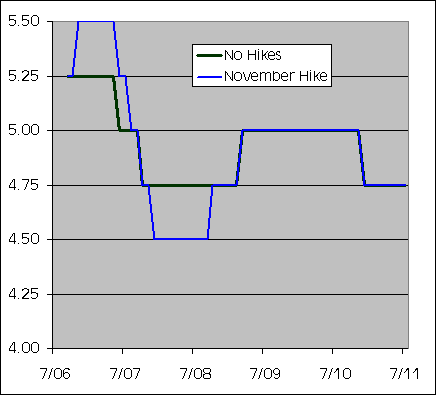On June 28, the 2-year closed at a yield of 5.28%. Right now it yields 4.93%. We all know what changed -- it is now widely assumed that the Fed will not hike rates on Wednesday, the first pause in 768 meetings. Or something like that. It is also widely assumed that there may be one more hike, perhaps in September, but that will be the last for the foreseeable future.
Is this justified or is it too far too fast. I took a look at some possible Fed Funds paths that would justify both where the 2yr, the 3yr, and the 5yr Treasuries are currently priced. To do this I assumed that the expected return on the 2yr is the same as the expected return of investing in overnight Fed Funds every day for the next 2 years. Same for the 3yr and 5yr. This is the arbitrage-free pricing theory of the yield curve.
I ran two scenarios. One where the Fed is already done hiking rates. The other where they make one more hike in September. I then played around with various points at which the Fed could start cutting rates, how much they would cut rates, and at what point another hiking cycle would begin. The point was not to make a projection of what the Fed will do, but to see what the Treasury market has priced in. I picked the one that both produced the current result but also resulted in a reasonable Fed path. Here is the graph:
If the Fed doesn't hike in September, they'd have to cut 3 times beginning in June 2007, with rates falling as low as 4.50%, to justify the 2-year. There would then need to be two hikes sometime between 2008 and 2010. The ending Fed Funds level would be 5%.
If the Fed does hike in September, it would need to be more aggressive in 2007, with 5 rate cuts between June and December. Fed Funds would bottom out at 4.25%. There would then need to be 2 hikes in 2008 and another in 2010.
Anyone can quibble with this analysis, because there are literally hundreds of possible paths. However, the point here is that for anyone to be bullish on the front-end of the yield curve, you have to be projecting more than 3 cuts in 2007 and more than 5 cuts if the Fed hikes again this year. I think that's a stretch.
Monday, August 07, 2006
Too much, too fast
Subscribe to:
Post Comments (Atom)



4 comments:
How psyched are banks to see lower FF? Some shape to the curve has got to help.
Thanks for the shout-out. We're up to about 70 hits/day, but still few comments.
Mario:
The real point of doing an analysis like this is to gauge the market's "base case." Let's say you make a simplistic investment decision like "I think the Fed will cut rates in 2007, and therefore I'm going to buy a 5-year bond." Well, based on my analysis your 5-year trade might not work out if the Fed only hikes once or twice.
If whatever you do only involves the short-end of the market, then forget about my analysis and watch FF futures. If you trade intermediate and/or long-term bonds, then FF futures are only part of the story.
As far as something more consistent, sorry. If the markets were more consistent, I wouldn't have a job. But as far as predicting short-term rates, other things I look at include euro-dollar futures, slope of the T-Bill curve, and implied swaption vol.
Actually, the implied forward inflation rate from TIPS is pretty interesting, and a bit more consistent than the forward yield curve. I've blogged about it a couple times. http://accruedint.blogspot.com/2006/07/tips-auction-goes-well.html
If you have to choose between buying a 3-month T-Bill or a 6-month T-Bill, how would you decide? Well, you'd think about whether the 3-month rate 3-months from now will be high enough to outperform just owning the 6-month. Since its an efficient market, we can assume that the slope of the curve between 3-months and 6-months indicates whether the market generally thinks short-term rates will rise or fall.
The market prediction was right :) Two of the three cuts predicted for 2007 happened today :)
Post a Comment